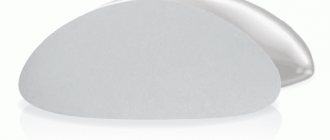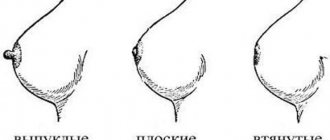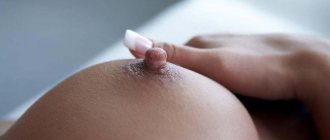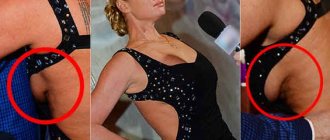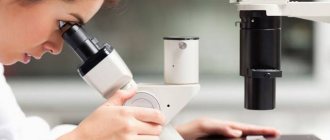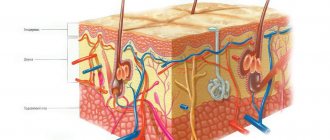Plastic surgery as a separate field of medicine today is developing rapidly and actively throughout the world and in Russia in particular. Modern women resort to services for a variety of operations, including facelifts, plastic surgery of the nose, chin and ears, liposuction of the abdomen, buttocks and other parts of the body. But breast correction surgery is especially popular – mammoplasty.
Decisions to undergo mammoplasty - breast correction surgery - are made for various reasons. A woman may be dissatisfied with the shape or size of her bust, its condition after pregnancy, breastfeeding or sudden weight loss, asymmetry of the mammary glands and wants to make a correction. But most often, mammoplasty is performed with the aim of enlarging the female breast, and in this case, implants, that is, endoprostheses, are used to achieve the desired shape and size of the breast.
The implants used in plastic surgery are different; there are several types. Endoprostheses vary in volume, shell surface texture, density, fillers, profile height and other parameters. This article on our website will discuss all types of breast implants. And here you can get answers to the most pressing questions, as well as find a lot of useful information about surgery and endoprostheses, which are usually used to enlarge the mammary glands.
Implants: what are they?
What is a breast implant? It is a prosthesis used to be inserted into a woman's breast. The implant consists of an outer shell as well as a filler. Various substances are used as the latter, and all of them must be compatible with natural tissues of the body, meet safety requirements and comply with generally accepted medical standards. Otherwise, there are risks of harm to health or even life. The shell must also be safe, hypoallergenic and strong enough so that the filler does not leak beyond its boundaries.
Breast implants are used in plastic surgery most often during breast augmentation surgery, when the patient is dissatisfied with its size and wants to get a larger volume. But endoprostheses can also correct the unattractive shape of the mammary glands. Implants can also correct other defects, for example, severe asymmetry, ptosis (drooping). Doctors use them after a radical or partial mastectomy for cancer treatment to restore and reconstruct the mammary glands after they have been removed.
Varieties
Many types of endoprostheses are used in plastic surgery. This variety allows you to choose the best option for any occasion and get excellent results.
The main classification parameter is the implant material. The survival rate and installation method depend on it.
What breast implants can be placed:
- Hydrogel (bio) – filled with carboxymethylcellulose, a natural polymer that is fully compatible with natural fabrics. When the shell ruptures, the material simply breaks down into glucose, carbon dioxide and water, and is eliminated from the body naturally. A completely safe filler, holds its shape perfectly and does not provoke inflammatory processes, looks natural and attractive.
- Silicone is a classic in endoprosthetics, consisting of an outer shell and an internal filler based on silicone gel. The best products are those with soft touch filler - this is a dense gel that optimally imitates the natural appearance and structure, and restores its shape when compressed. Silicone endoprostheses with standard cohesive gel are also popular for breast enlargement - their advantage is that if the shell is damaged, the jelly-like gel is completely absorbed and does not provoke complications. And another type of silicone is highly responsive - it is very dense, holds its shape excellently, and does not leak, but models based on it give the breasts an unnatural appearance and are too hard to the touch.
- Saline - pioneers of plastic surgery, the very first endoprostheses. Structurally, they consist of a silicone shell and saline filling. First, the shell is placed, and then it is filled with sodium chloride solution. Although it is also possible to install an already filled implant. Such models can be placed with minimal tissue incision, which reduces the trauma of the operation and improves the aesthetic effect due to the absence of scars. The solution itself is absolutely safe for the body. However, if the membrane ruptures, it will be necessary to undergo repeated breast surgery.
- Silica gel - filled with microscopic silicate balls. A distinctive feature is low weight. Silica gel products are very light, therefore they are suitable for large-sized prostheses; they do not weigh down the chest, do not overload the spine and prevent the development of ptosis.
Preference should be given to silicone models. They combine naturalness, elasticity, complete biocompatibility, safety, a wide selection of shapes and sizes, and, in addition, a reasonable price. Whereas bio implants are expensive, and silicate prostheses have not yet become widespread and cannot offer a wide range.
The surface of the implant can be smooth or porous. The latter is preferable, since it does not cause lumps in the breast and other complications, and does not provoke deformation of the endoprosthesis itself. In addition, a textured surface, as is the case with Motiva implants, provides a more secure fit and ensures that the implant does not move or tip over when moving.
How to enlarge breasts: with round and teardrop-shaped implants?
With all the variety of modern implants, they have only two shapes: round and teardrop-shaped, also ergonomic or anatomical.
Round
A universal option for augmentation, correction and mastopexy. Implants are widely used for asymmetry and mastoptosis. They perfectly imitate the natural shape, are easy to install and are affordable.
*Photos before and 2 years after hybrid breast augmentation (enlargement + lipofilling) with Motiva 265 ml round implants
teardrop-shaped
Such implants are noticeably more expensive, but this can be compensated by their advantages. They favorably follow the natural contours and shape of the mammary glands. Ideal for enlarging very small breasts. They are distinguished by high density and hold their shape well. Requires a more complex installation operation.
After inserting anatomical implants, it is advisable to abandon push-up bras and shapewear, as they can deform the prostheses.
How did breast implants come about?
The history of the development of breast implants began in the nineteenth century. The first unique surgical operation aimed at enlarging female breasts took place back in 1889. This procedure to add breast volume was performed using liquid paraffin as a material. Over time, doctors began to use other materials, sometimes unexpected and strange ones - wool, rubber, ivory fragments, glass beads. Only in the 61st year of the last century, specialists developed the world's first silicone breast implants.
The production of breast implants was also established in the Soviet Union, where bovine pericardium was first used to make the shells. Vegetable oils were used as filling. Next, the shells were modernized and made of latex rubber, natural rubber. Fillers were made from all kinds of materials, and saline solutions became the safest. But technology does not stand still: new fillers are constantly appearing, which are of high quality, have a structure close to natural and are not rejected by the human body.
Installation options depending on bone type
Often screws are implanted not only in a vertical position, but also in the central spongy tissue. It is this area that is most susceptible to atrophic processes and resorption after extraction. It is not always possible to use this area during therapy; some dentists resort to extensions.
Manufacturers have developed models designed for attachment to other types of bone structures:
- Basal and compression. They are located in the deepest layers that are not prone to atrophy. A well-known, time-tested brand is Oneway Biomed.
- Zygomatic Elongated, mounted at an angle exclusively on the upper jaw. Such structures are characterized by reliable fixation without deformation.
Should I use breast implants for mammoplasty: all the benefits
If you have not yet decided whether to enlarge your breasts with implants, then appreciate all the undeniable advantages of such plastic surgeries:
- The ability to solve a variety of patient problems - eliminating ptosis and asymmetry, increasing the size or restoring removed mammary glands due to cancer. All this can be discussed on the day of consultation with the doctor.
- A good result after just one operation: an increase in several sizes at once, a beautiful symmetrical shape, a toned, appetizing bust.
- Absolute safety. All implants used in clinics and plastic surgery centers are biocompatible, durable and of high quality, and also comply with standards and regulations. Certified endoprostheses undergo studies confirming the absence of health risks. And the surgical technique is refined to the smallest detail: surgeons with extensive experience and a high level of qualifications perform surgical interventions regularly, which ensures a result with 100% success during mammoplasty surgery and the absence of errors.
- Natural aesthetic appearance. Properly selected and well-installed implants are difficult to distinguish by eye and even by palpation from your own breast (especially if anatomical models are used).
- Maximum comfort. If the implants are optimally selected in size, texture and shape, then after the postoperative period they are not felt at all in the mammary glands and do not cause discomfort or unpleasant sensations.
- Low invasiveness of the operation. The installation of implants is performed under general anesthesia of the patient, and after the intervention, the plastic surgeon may prescribe painkillers to minimize the pain that occurs. The incisions in the access areas are small, so after surgery the sutures heal in a short time.
- Minimum risk of damage and especially rupture. The shell of silicone and other implants is very durable, due to which it is able to withstand mechanical stress (for example, mild impacts), does not burst due to pressure changes, and does not deform during active movements of the patient. A woman can absolutely lead a normal and familiar lifestyle.
- The probability of complications is close to zero. If there was a detailed consultation with a doctor, the operation was performed in a licensed clinic by an experienced and highly qualified plastic surgeon, high-quality implants were used, and the woman followed all the rules for successful rehabilitation after the intervention, then there are no risks of undesirable consequences.
Currently, there is simply no alternative to augmentation surgery performed with implants. If reduction or mastopexy (lift surgery) is sometimes possible to perform without endoprostheses, then increasing the bust by several sizes, as well as significantly adjusting its shape, is only possible with silicone implants.
Orthopedic stage
Goal: complete restoration of the integrity of the dentition.
The doctor takes impressions. After the crown is made in a dental laboratory, it is placed on the implant.
Or, a fixed full prosthesis on 4 or 6 implants is manufactured and installed.
Our dental clinic performs dental implantation at a price of 18,000 rubles.
Still have questions about how dental implants are placed? Sign up for a free consultation with an implant surgeon by phone. +7 495 369 94 71 and receive detailed answers to your questions!
What are breast implants: the main differences
What types of breast implants are used in plastic surgery, and how do they differ from each other?
Each prosthesis has its own basic parameters in which they differ:
- form;
- filler material;
- type of shell surface;
- profile height;
- size.
Currently, there are a large number of different models of breast implants with different characteristics on the global and Russian market, so it is especially important to choose the most suitable option in a particular case so that the results of the operation meet the patient’s expectations, the aesthetic effect corresponds to the patient’s preferences, and the risks of postoperative complications are minimal .
Types of breast implants
The times when an implant was solely a hemisphere filled with liquid are gone. Surgeons use different models, which vary:
- by filler;
- to size;
- according to form;
- by surface type.
The plastic surgeon selects the product, taking into account the physiology of each individual patient, as well as his wishes for the shape and size of the bust. Each type of breast implant has its own characteristics, which the doctor takes into account when planning the operation.
Form options
Round
teardrop-shaped
Cone-shaped
Until recently, there were only two options for the shape of implants, but recently a third one has appeared. Let's look at everything:
- Round form. Round implants have a hemispherical configuration and have the so-called “push-up” effect, that is, the final result creates the most elevated breasts, making them more voluminous - this is their main distinguishing characteristic. Endoprostheses of this form are used for augmentation mammoplasty, if it is necessary to correct asymmetry, increase the size by several points at once, eliminate ptosis after pregnancy or that has arisen against the background of inevitable age-related changes. A big advantage of round-shaped implants is the preservation of their natural original appearance even during rotation: displacements and changes in position almost do not change the contours of the prosthesis in the chest, and migrations remain almost unnoticeable. Therefore, this form is recommended if the desired goal of breast surgery is to increase the size with preferential filling of the central region and the upper pole of the gland. The cost is low compared to other types.
- Drop shape. It is also called anatomical, and it is considered the most natural, since it looks as natural as possible and is practically no different from the natural female breast, according to numerous reviews from women. Anatomical implants allow you to correct asymmetry, model the shape, shift the focus to the lower segment and reduce the distance between the glands, which is of great importance in terms of aesthetics. But the choice of teardrop-shaped prostheses is not suitable for low-set busts, and is also not used for severe ptosis. Anatomically shaped implants also have a significant drawback: when displaced, they look unnatural, since the contours appear through the mammary gland and cause changes in its outline. In addition, after installation of anatomical drop-shaped endoprostheses, it is undesirable to wear push-up bras, as they can deform the implants. The price of such implants is higher when compared with round models.
- Cone shape. This is a relatively new development designed for women who have tubular breasts, that is, a pointed shape. But not all manufacturers have such models in their lineups, and their prices are quite high. The cost of round and anatomical endoprostheses is lower.
Good to know!
When implants that have an anatomical shape are displaced, a repeat mammoplasty operation is almost always necessary - re-endoprosthetics. Moreover, previously installed endoprostheses are often replaced.
Eurosilicone implants
The first Eurosilicone laboratory appeared in 1988.
Its founder, Donald McGahn, set the main goal to organize production and make the company an industry leader. In 1997, they merged with another manufacturer, Europrotecs, and two years later moved their headquarters and all production to the French town of Apt. In 2004, the company merged with MEDICOR Ltd with the goal of becoming a world leader in the production of breast implants and other medical products for plastic surgery. Today Eurosilicone is the largest breast implant company in Europe and the third largest in the world. It produces 800 thousand endoprostheses per year, employing about 300 specialists in production.
Eurosilicone implants (manufactured by EUROSILICONE SAS, France) have undergone research/testing for safety indicators in the Russian Federation according to the procedure established by law and are declared. Declaration dated May 24, 2018 No. ROSS.FR.MG11D13761 (valid until May 23, 2021). They have been registered on the territory of Russia and are approved for use on the basis of RU dated 06/09/2010 No. FSZ 2010/07171. The endoprostheses comply with the requirements of ISO (international product manufacturing standard) and EU standards, as evidenced by the CE certificate confirming the compliance of the implants with the requirements of Medical Device Directive 93/42/EEC.
American silicone NewSil is used as the starting raw material in production. Both the shell and the cohesive gel are made from it. The company uses its own laboratory to develop implants using innovative technologies. Features of Eurosilicone implants include a thirteen-layer 450-micron shell with Nusil barrier properties, which prevents the filler from sweating. Each of them differs in density and strength. The implant is reliably protected from ruptures. Even in the event of mechanical damage to the shell, the cohesive gel will not penetrate outside.
The process innovation lies in the texture creation process. The relief is created by molten silicone, onto which sodium chloride crystals are applied. After the polymer mass has hardened, the workpiece is sent to the oven for polymerization. The process is repeated several times. This technology makes it possible to create a surface that ensures optimal encapsulation of the implant in the postoperative period and prevents rotation, that is, rotation of the endoprosthesis and securely fixes it in a given position.
There are four types of implants in the Eurosilicone line:
- Paragel
- 139 modifications of round endoprostheses.
Presented in two series : Sculpturale
and
Cristalline
with a textured surface. An impermeable liner is placed under the outer shell layer. - Vertex
- anatomically shaped, includes an additional plate that is sewn to the broad chest muscle. In this way, its displacement is prevented and reliable fixation is ensured. - Aptex
- anatomically shaped with a jelly-like cohesive filler and a Nusil shell. - Komuro
is an anatomically shaped low-profile implant that is easy to install through an endoscopic micro-incision in the armpit. This is the most gentle way to install an implant.
Eurosilicone provides a lifetime guarantee on all medical products. Each implant has a serial and identification number. It is entered into a database and tracked from the moment the operation is completed. Feedback is established between the company and patients. Previously manufactured implants have been tracked for over ten years. During this time, no complications related to the quality of endoprostheses were identified.
Variety of filler materials
There are several different types of fillers available for breast implants, but only two of them are fully approved by the Food and Drug Administration (called the FDA for short). This is a saline solution, as well as the usual and widespread silicone. But below we will look at all the options.
For your information!
Implant shells are made of dense silicone, usually multilayer.
Saline solution
A saline solution, also called saline or sodium chloride, is placed into the implant shell through a valve after the prosthesis is installed. The advantages of this choice include safety and spontaneous removal of material by the body if the endoprosthesis ruptures. It is also possible to place implants in the breast through small incisions, including near the areola. The affordable price is also a plus.
There are also disadvantages. The first is the likelihood of gurgling sounds when the prosthesis is not filled enough. The second is less strength when compared with silicone models. The third is minimal elasticity, which affects tactile sensations and shape. Contouring and deformations are possible.
Silicone
Initially, liquid silicone was used to enlarge the mammary gland, but it often “sweated,” that is, seeped through the membrane and got into the breast tissue. Therefore, recently only modern and safe silicone compounds have been used. These are cohesive gels that differ in density, that is, cohesiveness.
Each manufacturer uses its own classification of cohesive gels for breast plastic surgery, but usually there are the following three degrees of density:
- "Soft touch". Such silicone gels are the least dense and very soft, therefore they resemble natural female breasts to the touch and also behave naturally when moving.
- Medium-cohesive, that is, standard silicone gels have a medium degree of density, very similar in structure to the glandular tissue of the breast.
- Highly cohesive gels. A silicone implant filled with this type of gel has a high density, due to which a memory effect is achieved (Memory Gel): the shape is maintained in a constant state and is not subject to deformation.
The advantages include elasticity, aesthetic appearance, natural tactile sensations, which is confirmed by reviews, videos and photos of surgeons’ work. In addition, even if the implant is damaged, due to the integrity of the gel with the shell and the high density of the material, silicone will not migrate throughout the body, remaining in the mammary gland area.
But there are also disadvantages. Firstly, the incisions for installing silicone implants must be larger than for saline implants. Secondly, ruptures of silicone endoprostheses often go unnoticed.
Hydrogel
Biocompatible hydrogel is also called biogel or bioimplant. Such endoprostheses are produced on the basis of carboxymethylcellulose, a naturally occurring polymer.
There are many advantages. Firstly, when the biogel migrates outside the shell, the gel breaks up into separate components - water with carbon dioxide and glucose. All these substances are eliminated very quickly and naturally without causing harm. Secondly, due to its high elasticity, access can be created with small incisions. Thirdly, the structure of the biogel is similar to the glandular tissues of the breast, which creates a natural appearance and natural shape. Fourthly, when bioimplants are installed, capsular contracture develops less frequently.
There are also disadvantages. The first is the lack of official FDA certification. For this reason, the choice of bioimplants is not allowed for breast augmentation in some countries. The second disadvantage is the possibility of damage to the shell. The third negative point is the gradual dissolution of the biogel with a subsequent decrease in the size of the mammary gland. And such endoprostheses are also the most expensive.
Silica gel
Silica gel dentures are filled with gel and special small silicate balls. The advantages include low weight (30% lighter than saline and silicone endoprostheses), minimal risks of breast ptosis and the possibility of using large implants. In addition, such prostheses give a woman’s breasts a natural appearance.
But silica gel models began to be used recently, so they have not undergone large-scale and long-term clinical trials. It is impossible to say exactly how such an implant for female breast enlargement will behave after a year, 10, 15 or 20 years.
Surgical stage
Purpose: preparation of the site for implant installation, implantation of an artificial root, formation of the correct gum contour.
Under local anesthesia, the implantologist sequentially performs the following 4 surgical procedures:
Dissection of gum tissue
To gain access to the bone of the lower or upper jaw, the doctor makes a small incision in the gum and removes the flaps.
Formation of a landing channel for an implant
Using a surgical template, the doctor drills a channel of the required depth and width into the spongy tissue.
The doctor measures the resulting depth of the canal in the bone tissue and compares it with the required value.
Performs smooth boring of the channel to the planned width. Drills of different diameters are used sequentially.
Fixation of titanium rod
An implant is placed in the hole.
First, the artificial root is implanted using an electrical device. It is then screwed in by hand until it matches the edge of the bone.
The implant is closed with a temporary plug.
Gum suturing
The edges of the incisions are sutured to close the plug.
After the implant has healed (3-4 months on the lower jaw and 4-6 months on the upper jaw), to give the gum an aesthetic contour, the plug is removed and a gum former is placed.
A maximum of 14 days after installation of the gum former, it is replaced with an abutment - the connecting link between the implant and the orthopedic structure.
A temporary coping is placed on the abutment for taking impressions.
What could the texture be?
The surface of the shell of any breast implant may have the following texture:
- Rough, that is, textured. Thanks to such a surface, the implant takes root much faster and practically does not migrate and does not provoke capsular contracture. But implants with such shells are denser and harder to the touch.
- Nanotextured. The surface is rough and microporous; it also reduces the risk of contracture, is more pleasant to the touch and is also well fixed.
- Smooth. This surface is pleasant and soft to the touch, but often provokes the formation of capsular contracture and also increases the risk of displacement of prostheses in the chest.
In the near future, approximately within a month or two after surgery, a capsule consisting of connective tissue cells will in any case form around the implant. This is a kind of protective reaction of the body to the invasion of a foreign object. But the capsule shell may be too dense, deforming the implant. This process, called capsular contracture, will require a capsulotomy - removal of the hard capsule that has formed. Surgeons also often suggest replacing implants in order to install others that are not likely to cause the same unwanted connective tissue reaction.
Implant structure
Silicone endoprostheses consist of a shell and a filler.
Filler
Typically, the implant is filled with high-viscosity silicone gel. It has good elasticity and holds its shape well. However, if it ruptures and leaks, it is dangerous, and gradually, when wearing an endoprosthesis, flows into its lower part, which reduces the aesthetic effect. The filler is not always silicone of varying degrees of cohesiveness (viscosity). There are implants filled with saline solution, with different projections and sizes.
Cohesive gel is also used. It is soft and provides a natural effect: the silicone implant looks like a real breast and at the same time has a “memory” effect, that is, it returns to its original shape when subjected to deformation.
Shell
Most products today have a textured shell that allows natural ingrowth of the surrounding soft tissue. This ensures good fixation of the endoprosthesis in place and reduces the likelihood of capsular contracture.
Profile
The profile is a value that shows how much the breast protrudes forward after the installation of implants. The higher this indicator, the more convex the mammary glands. There are four options:
Ultrahigh
High
Average
Short
- The ultra-high profile has the highest degree of protrusion: the chest becomes as prominent as possible.
- The high profile is shaped like half a sphere (ball).
- The middle profile is flatter, giving it a natural look.
- Short. Implants of this profile do not protrude much above the level of the chest area.
Alternative Methods
All options considered involve the implantation of screws into the bones. Nowadays all implantation materials are screwed in this way. An artificial metal root completely replaces the natural one. The implant has a similar appearance and is placed in almost the same area. Additional segments may be affected at greater depth.
Intramucosal technology for installing dental implants
The pin is not screwed into the bone structures, but directly into the gums and a little deeper. This way the installed structure will not fall out. Outwardly, it resembles buttons, and not an imitation of the root part of the unit.
The technique is gradually becoming a thing of the past due to its fragility. There is a high probability of complications (injury, inflammatory processes).
Endodontic-endosseous method
This option is also outdated. A device in the form of a small awl is inserted into the root canal, then it is moved slightly beyond its limits and fixed in hard tissues. It was used mainly in the presence of a mobile or broken incisor, canine, or molar. Such fixation is difficult to implement and becomes loose over time. The technology is not suitable for long-term restoration and is indicated for patients with narrow-shaped canals.
Mini implantation
How dental implants are inserted: tooth installation technology involves shallow immersion into bone structures. Over time, the pins become loose, the fastenings wear out, which means the prosthesis becomes mobile and causes severe discomfort.
This method is welcomed only as a short-term method while the patient is undergoing long-term therapy. For example, this happens when restrictions are discovered on the use of more “long-lasting” techniques. The treatment period is up to 5 days. The prosthetics are removable; screws can be inserted even in cases of complete edentia.
What volume to choose
Implant sizes are measured in milliliters. On average, a volume of 150 ml corresponds to the first breast size. The next step is 100-200 milliliters, depending on the shape, profile and other parameters.
It is believed that the larger the breast size with installed implants, the more attractive the bust. But in fact, overly voluminous endoprostheses can look unnatural. And in order to find the golden mean, one should take into account the initial size of a woman’s own mammary glands, the elasticity of her skin, build, width of the sternum, as well as other anatomical individual features.
Important! It is worth noting that the final actual size depends on many factors, and the same implants may look different for different women.
Implant volume: the larger the better?
Among women who have never had breast surgery, there is an opinion that the larger the volume of the breast implant, the larger the breasts will be. This is mistake. In fact, breast size after plastic surgery depends on many factors:
- original bust size;
- the patient's height and weight;
- skin condition, level of elasticity
- chest width and other anatomical features;
- volume, diameter and profile of the implant.
*Photos before and after breast augmentation with Motiva implants of 345 and 450 cc
It often happens that a silicone implant of the same volume looks different on women with different builds and other individual characteristics. Therefore, to get larger breasts, focusing only on the size and volume of the prosthesis is not enough.
Manufacturers
The implants used for female breast augmentation surgeries are manufactured by different companies. The most popular and proven are “Mentor”, “Natrelle” (“Allergan”). Endoprostheses from different manufacturers vary in materials, shapes and prices.
One of the best and leading brands with an excellent reputation, according to reviews from plastic surgeons and women, is “Silimed”. These implants are of high quality, have quality certificates, have excellent strength and reliability, and also perfectly imitate natural female breasts both visually and to the touch. The Silimed line includes many models, among which you will definitely be able to choose the best option. The official manufacturer provides a guarantee for implants, which indicates high quality.
Estimated prices for implants for mammoplasty
The cost of endoprostheses depends on the materials used in production, the brand name, and the complexity of the process. For 1 implant you have to pay from 20,000 rubles to 100,000 rubles. Round endoprostheses with a smooth surface and liquid filling are the cheapest. This doesn't mean they are bad. Such implants have all quality certificates, and sometimes are the only possible options for indications.
When comparing implant prices, you need to study the manufacturer and market representative in your country. There is a well-known story about prostheses from the French company PIP, which were filled with a dangerous technical gel that tended to slowly leak through the shell. Patients who underwent mammoplasty underwent surgery to replace implants, but not all victims could be identified.
Prices
How much does a breast implant cost? The price depends on the city in which the clinic is located, on the manufacturer, as well as on the specific model and its parameters (profile, shape, filler).
Approximate prices for surgery in different countries:
| A country | Approximate prices |
| India | from 1,300 $ |
| Türkiye | from $2,300 |
| Thailand | from $3,200 |
| South Korea | from $3,300 |
| Mexico | from $3,500 |
| Ukraine | from $3,500 |
| Czech | from $3,550 |
| UAE | from $3,700 |
| Germany | from $8,500 |
| Israel | from $8,500 |
| Spain | from $9,450 |
| Austria | from $11,100 |
| Italy | from $12,900 |
| Switzerland | from $17,000 |
| RF | from $17,100 |
| Collapse listView entire list | |
In Moscow, the average cost of a pair of round endoprostheses made of silicone with a textured shell is about 1000 euros, and anatomical ones - about 1200 euros. Bioimplants cost about 3500-4000 euros.
| NewMe Plastic Surgery and Cosmetology Clinic | from |
| Breast augmentation + cost of implants included | 300000 ₽ |
| Perioareolar (circular) lift + breast augmentation | 330000 ₽ |
| Vertical lift + breast augmentation | 330000 ₽ |
| Vertical breast lift | 265000 ₽ |
| T-inverse breast lift | 265000 ₽ |
| Areola correction | 150000 ₽ |
| Plastic surgery of inverted nipples | 100000 ₽ |
| Endoscopic breast augmentation, axillary augmentation | 305000 ₽ |
| Breast reduction (reduction) | 300000 ₽ |
| Breast reconstruction | 560000 ₽ |
| Elimination of Poland syndrome | 500000 ₽ |
Service life: will replacement of implants be required?
The service life depends on the generation and manufacturer of the implants. For endoprostheses of previous generations, the duration of use usually does not exceed 10-15 years. More modern models can last up to 20-30 years.
Some manufacturers provide a lifetime guarantee, but even with maximum service life of the implants, repeated revision breast surgery may be indicated.
The need for re-endoprosthetics arises under a number of conditions:
- Ptosis is sagging of the breasts due to the weight of implants. A lift will be required with the installation of new implants.
- Rotation (change of position). Either one breast implant or both at once can move.
- Deformation or damage to the prosthesis under certain circumstances, for example, after injury.
- Mistakes made by the surgeon when choosing implants or installing them.
- A woman’s voluntary desire to re-adjust the shape, increase or decrease the size.
- Broken integrity of the breast prosthesis shell, penetration of the filler into the breast tissue.
- Complications that arise after plastic surgery, due to the individual characteristics of the body or the patient’s failure to comply with the surgeon’s recommendations. The list of consequences may include tissue infection, suture dehiscence, and inflammatory reactions.
- The appearance of severe capsular contracture.
- The appearance of various aesthetic defects, for example, folds, asymmetry, double contour.
Note!
In most cases, it is unrealistic to influence the service life in any way, but you can avoid damage to breast implants and their premature replacement if you go to a good clinic and an experienced surgeon, follow the rules of rehabilitation after plastic surgery, and also avoid mechanical stress.
Options for installing breast implants
In addition to the type of breast implant, the installation option is very important. The shape of the new bust and the risk of some complications depend on this. Surgeons use the following methods of placing implants in tissues:
- under the mammary gland;
- under the pectoral muscles;
- mixed option.
The subglandular location of the implant may be suitable for women with large breasts, since the volume of their own tissues masks the edges of the prosthesis. The main advantages of this installation: a significant reduction in healing time and minimal tissue swelling after the intervention.
Location disadvantages:
- risk of contouring the edges of the implant through the skin;
- increased chance of developing capsular contracture and ripping (“washboard effect”);
- breast sagging over the years under the weight of the prosthesis;
- possible distortion of mammography results.
If the implant is located under the muscle, recovery from surgery may take longer. But the prosthesis is not visible even in thin women, the breasts do not sag over time, and when examining the gland, the picture remains clear.
There is a mixed option for installing breast implants. In this case, the upper pole of the prosthesis is hidden under the muscles, and the lower pole is located under the breast tissue. This technique combines the advantages of both types of placement:
- low risk of breast sagging, capsular contracture, ripping;
- natural appearance of breasts;
- no distortion during mammography.
Plastic surgeons at the GALAXY Beauty Institute select the appropriate option for installing implants, taking into account the characteristics of each individual patient.
The main disadvantage of the technique is the increase in operation time and tissue recovery time.
